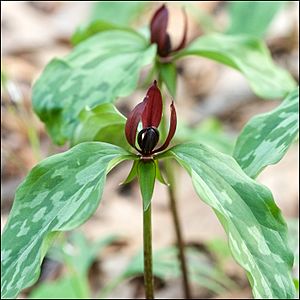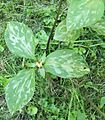Prairie trillium facts for kids
Quick facts for kids Prairie trillium |
|
|---|---|
 |
|
| In Little Rock, Arkansas, showing recurved sepals | |
| Conservation status | |
| Scientific classification | |
| Genus: |
Trillium
|
| Species: |
recurvatum
|
| Synonyms | |
|
|
The prairie trillium, also known as Trillium recurvatum, is a beautiful flowering plant. It's a type of perennial plant, which means it lives for more than two years. This plant is part of the Melanthiaceae family.
You can find the prairie trillium growing in the central and eastern parts of the United States. It lives in places like Iowa, Texas, North Carolina, and Pennsylvania. These plants like to grow in damp forests and open grasslands called savannas. They often prefer soils that have a lot of calcium, like limestone.
This plant has many interesting nicknames. Some people call it toadshade or bloody butcher. Other names include bloody noses, red trillium, prairie wake-robin, and purple trillium. It's also known as reflexed trillium because of how its sepals (leaf-like parts under the petals) bend downwards.
What Does It Look Like?
The prairie trillium can grow up to about 40 centimeters (about 16 inches) tall. It has three large, oval-shaped leaves that are often mottled, meaning they have patches of different shades of green. These leaves can be 6 to 18 centimeters (about 2.4 to 7 inches) long and 2 to 6.5 centimeters (about 0.8 to 2.6 inches) wide. As the plant gets older, these leaves develop small stems.
The Flower
The flower of the prairie trillium is quite unique. It has three petals that are usually brown or maroon in color. These petals are about 1.8 to 4.8 centimeters (about 0.7 to 1.9 inches) long and 0.9 to 2 centimeters (about 0.35 to 0.8 inches) wide. The tips of the petals curve over the stamens, which are the parts that produce pollen.
A special feature of this plant is its sepals. Unlike many other flowers, the sepals of the prairie trillium point downwards once the flower is fully open. The anthers, which are part of the stamens, are also a dark purple color and can be up to 16 millimeters (about 0.6 inches) long. The stigmas, which receive pollen, have tips that also curve downwards. This downward-pointing sepal helps tell it apart from other similar Trillium species.
Fruit and Seeds
After the flower blooms, it produces a green fruit. This fruit sometimes has streaks of purple or white. It also has six clear ridges on its surface. Inside the fruit are the seeds. These seeds have a special, oily part called an elaiosome. This elaiosome is very attractive to ants and other insects. When ants find the seeds, they carry them away to eat the elaiosome. This helps the plant spread its seeds to new places.
Conservation Status
The prairie trillium is generally common in most areas where it grows. It is not considered to be in danger of disappearing globally. Its overall status is thought to be secure, meaning it's doing well.
However, in some states, especially at the edges of its natural range, the plant is less common. Because of this, conservation groups in those states keep a close eye on it. For example, in Wisconsin, it's considered rare or uncommon. This means it's a "species of special concern" there. In Michigan, the prairie trillium is even more rare and is listed as a "state threatened species." This means it is protected by law in Michigan to help ensure its survival.
Images for kids






